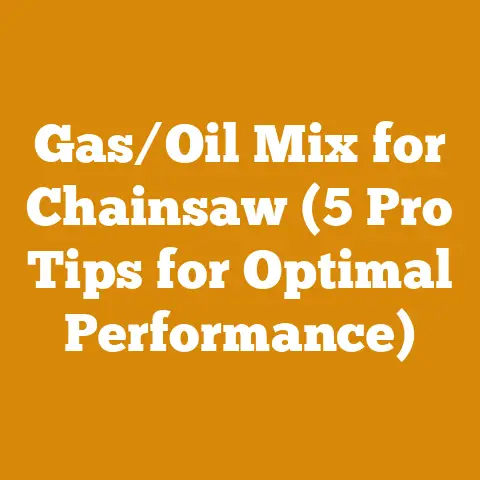Ported Exhaust Upgrades (Saw Performance Boosts Explained)
Let’s get started.
Unleashing Your Chainsaw’s Potential: A Deep Dive into Ported Exhaust Upgrades
Blending styles.
That’s what it’s all about when you’re talking about getting the most out of your chainsaw.
Just like a master chef carefully balances flavors, we, as chainsaw users, are constantly striving for that perfect blend of power, efficiency, and control.
In my years of felling trees, bucking logs, and splitting firewood, I’ve learned that often, the factory settings on our saws leave a lot of untapped potential on the table.
And one of the most effective ways to unlock that potential?
Upgrading the exhaust port.
I’ve seen firsthand how a well-executed exhaust port modification can transform a sluggish saw into a real beast, capable of chewing through hardwoods with ease.
But it’s not just about brute force; it’s about optimizing the engine’s breathing to achieve a smoother, more responsive power curve.
Key Takeaways You’ll Learn:
- The Science Behind Exhaust Porting: Understand how exhaust port modifications affect your chainsaw’s engine performance.
- Benefits of a Ported Exhaust: Explore the advantages of increased power, improved throttle response, and cooler engine temperatures.
- DIY vs.
Professional Porting: Weigh the pros and cons of performing the modification yourself versus hiring a professional. - Step-by-Step Guide to Porting: Learn the tools, techniques, and safety precautions involved in porting your chainsaw’s exhaust.
- Tuning and Optimization: Discover how to properly tune your chainsaw after porting to maximize its performance.
- Potential Risks and Considerations: Understand the potential downsides of porting, including warranty implications and engine damage.
Why Bother with Exhaust Porting? My Personal Journey
My journey into the world of chainsaw modifications began, like many, out of necessity.
I was running a small firewood business, and my trusty Stihl MS290, while reliable, was starting to feel underpowered, especially when tackling larger-diameter oak and maple logs.
I knew I needed more grunt, but I wasn’t quite ready to invest in a brand-new, professional-grade saw.
That’s when I stumbled upon the concept of exhaust porting.
The idea of tweaking the engine’s airflow to extract more power intrigued me.
I started researching, reading forums, and watching countless videos.
The more I learned, the more convinced I became that this could be the answer to my power woes.
My first attempt was… well, let’s just say it wasn’t perfect.
I was a bit too aggressive with the grinder, and the saw ran rough for a while.
But I learned from my mistakes, refined my technique, and eventually, I achieved the results I was looking for.
The difference was night and day.
My MS290, once a struggling workhorse, was now a veritable beast, capable of slicing through hardwoods with surprising speed and efficiency.
This experience sparked a passion for chainsaw modification that has stayed with me ever since.
I’ve since ported numerous saws, both for myself and for friends and colleagues in the wood processing industry.
Along the way, I’ve gained a deep understanding of the science and art of exhaust porting, and I’m eager to share that knowledge with you.
The Science of Exhaust: Understanding the Engine’s Breathing
To truly understand the benefits of exhaust porting, you need to grasp the fundamentals of how a two-stroke engine works.
In a nutshell, the engine cycle involves four key stages: intake, compression, combustion, and exhaust.
The exhaust port plays a crucial role in the final stage, allowing the burnt gases to escape the cylinder after the combustion process.
The size, shape, and timing of the exhaust port directly affect how efficiently these gases are expelled.
Here’s a simplified breakdown:
- Combustion: The air-fuel mixture ignites, pushing the piston down the cylinder.
- Exhaust Port Opens: As the piston moves down, it uncovers the exhaust port, allowing the burnt gases to escape.
- Scavenging: The incoming fresh air-fuel mixture helps to push out the remaining exhaust gases.
- Exhaust Port Closes: As the piston moves back up, it covers the exhaust port, trapping the fresh charge in the cylinder for the next cycle.
The Problem with Stock Exhaust Ports:
Factory exhaust ports are often designed with compromises in mind.
Manufacturers must balance performance with factors like emissions regulations, noise restrictions, and engine longevity.
As a result, stock exhaust ports are often smaller and less efficient than they could be.
This restriction can lead to several problems:
- Backpressure: The exhaust gases struggle to escape the cylinder, creating backpressure that hinders the engine’s ability to rev freely.
- Reduced Power: The inefficient exhaust flow limits the amount of fresh air-fuel mixture that can enter the cylinder, reducing overall power output.
- Increased Engine Temperature: The restricted exhaust flow can cause the engine to run hotter, potentially leading to premature wear and damage.
How Porting Improves Exhaust Flow: The Art of Shaping the Escape
Exhaust porting involves modifying the exhaust port’s size, shape, and timing to improve the flow of exhaust gases.
The goal is to reduce backpressure, increase scavenging efficiency, and ultimately, unlock more power from the engine.
Key Porting Techniques:
- Widening the Port: Increasing the width of the exhaust port allows more exhaust gases to escape at once, reducing backpressure.
- Raising the Port: Raising the height of the exhaust port changes the port timing, allowing the exhaust gases to escape earlier in the engine cycle.
- Smoothing and Polishing: Smoothing the port surfaces reduces friction and turbulence, further improving exhaust flow.
- Shaping the Port: Optimizing the port’s shape can help to direct the exhaust gases more efficiently.
The Impact of Porting on Engine Performance:
When done correctly, exhaust porting can have a dramatic impact on engine performance.
I’ve seen gains of 10-20% in horsepower and torque, along with improvements in throttle response and engine cooling.
Here’s what you can expect:
- Increased Power: The engine can rev higher and produce more power throughout the RPM range.
- Improved Throttle Response: The engine responds more quickly to changes in throttle input.
- Cooler Engine Temperatures: The improved exhaust flow helps to dissipate heat more effectively.
- Smoother Power Curve: The engine delivers a more consistent and predictable power output.
DIY vs. Professional Porting: Which Path is Right for You?
Now, let’s address the big question: should you attempt to port your chainsaw’s exhaust yourself, or should you hire a professional?
The answer depends on your skill level, experience, and willingness to take risks.
DIY Porting: The Pros and Cons
Pros:
- Cost Savings: Porting your own saw can save you a significant amount of money compared to hiring a professional.
- Learning Experience: You’ll gain a deep understanding of your chainsaw’s engine and how it works.
- Customization: You have complete control over the porting process and can tailor it to your specific needs.
Cons:
- Risk of Damage: If done incorrectly, porting can damage your engine, potentially requiring expensive repairs.
- Time Commitment: Porting a chainsaw takes time, patience, and attention to detail.
- Specialized Tools Required: You’ll need to invest in specialized tools, such as a rotary tool with various bits.
- Warranty Voidance: Porting your chainsaw may void the manufacturer’s warranty.
Professional Porting: The Pros and Cons
Pros:
- Expertise and Experience: A professional porter has the knowledge and experience to port your chainsaw safely and effectively.
- Guaranteed Results: Many professional porters offer a satisfaction guarantee.
- Reduced Risk of Damage: The risk of damaging your engine is significantly lower when you hire a professional.
Cons:
- Higher Cost: Professional porting can be expensive.
- Less Control: You may have less control over the porting process.
- Finding a Reputable Porter: It can be challenging to find a qualified and trustworthy porter.
My Recommendation:
If you’re new to chainsaw modification, I recommend starting with simpler projects, such as muffler modifications or carb adjustments.
Once you’ve gained some experience and confidence, you can consider tackling exhaust porting.
However, if you’re not comfortable working on your chainsaw’s engine, or if you’re concerned about voiding the warranty, it’s best to hire a professional.
A Step-by-Step Guide to Porting Your Chainsaw’s Exhaust (For Experienced Users Only)
Disclaimer: This guide is intended for experienced chainsaw users who are comfortable working on their engines.
Porting your chainsaw can be risky, and if done incorrectly, it can damage your engine.
Proceed at your own risk.
Tools and Materials You’ll Need:
- Rotary Tool (e.g., Dremel) with Various Bits: Carbide cutters, grinding stones, sanding drums, and polishing wheels.
- Safety Glasses: Protect your eyes from flying debris.
- Dust Mask: Protect your lungs from harmful dust.
- Gloves: Protect your hands from sharp edges.
- Measuring Tools: Calipers, rulers, and protractors.
- Marking Tools: Sharpie markers and scribes.
- Files: Small files for fine-tuning the port.
- Compressed Air: For cleaning the cylinder.
- Spark Plug Wrench: For removing the spark plug.
- Piston Stop: To prevent the piston from moving while you’re working.
- Service Manual: Refer to your chainsaw’s service manual for specific instructions and torque specifications.
Step 1: Preparation
- Clean Your Work Area: Ensure you have a clean, well-lit workspace.
- Disassemble the Chainsaw: Remove the muffler, spark plug, and any other components that might get in the way.
- Secure the Cylinder: Use a vise or other clamping device to hold the cylinder securely.
Be careful not to damage the cylinder walls. - Insert the Piston Stop: Insert the piston stop into the spark plug hole to prevent the piston from moving.
Step 2: Marking the Port
- Inspect the Stock Port: Carefully examine the stock exhaust port and note its size, shape, and location.
- Determine Your Porting Goals: Decide how much you want to widen, raise, or shape the port.
- Mark the New Port Boundaries: Use a Sharpie marker or scribe to mark the new boundaries of the exhaust port.
Be precise and accurate.
Step 3: Porting the Exhaust
- Start with a Coarse Bit: Use a carbide cutter or grinding stone to remove the bulk of the material.
- Work in Small Increments: Remove small amounts of material at a time, constantly checking your progress.
- Maintain a Smooth and Consistent Shape: Avoid creating sharp edges or abrupt transitions.
- Use Lubricant: Apply a small amount of lubricant (e.g., cutting oil) to the bit to prevent it from overheating and clogging.
- Alternate Between Bits: Switch between different bits to achieve the desired shape and finish.
- Pay Attention to Detail: Focus on creating a smooth, efficient flow path for the exhaust gases.
Step 4: Finishing and Polishing
- Use Finer Bits: Switch to finer grinding stones and sanding drums to smooth the port surfaces.
- Polish the Port: Use a polishing wheel and polishing compound to create a mirror-like finish.
- Remove Sharp Edges: Use a file to remove any sharp edges or burrs.
Step 5: Cleaning and Reassembly
- Clean the Cylinder: Use compressed air to remove all traces of metal shavings and debris.
- Reassemble the Chainsaw: Reinstall the muffler, spark plug, and any other components you removed.
- Check for Leaks: Start the chainsaw and check for any exhaust leaks.
Important Considerations:
- Port Timing: Be careful not to raise the exhaust port too high, as this can negatively affect low-end torque.
- Port Shape: Experiment with different port shapes to find what works best for your chainsaw.
- Material Removal: Avoid removing too much material, as this can weaken the cylinder.
- Safety: Always wear safety glasses, a dust mask, and gloves when porting your chainsaw.
Tuning and Optimization: Fine-Tuning Your Saw for Peak Performance
Once you’ve ported your chainsaw’s exhaust, it’s crucial to tune and optimize the engine to take full advantage of the modifications.
Porting changes the engine’s airflow characteristics, which means you’ll likely need to adjust the carburetor settings to ensure the engine is running optimally.
Carburetor Adjustments:
The carburetor controls the air-fuel mixture that enters the engine.
It has three main adjustment screws:
- Low (L) Screw: Controls the fuel mixture at idle and low RPMs.
- High (H) Screw: Controls the fuel mixture at high RPMs.
- Idle Speed (T) Screw: Controls the engine’s idle speed.
Tuning Procedure:
- Start the Chainsaw: Warm up the engine to its normal operating temperature.
- Adjust the Idle Speed: Turn the idle speed screw until the engine idles smoothly without stalling.
- Adjust the Low Screw: Turn the low screw until the engine responds quickly to throttle input without hesitating or bogging.
- Adjust the High Screw: Turn the high screw until the engine runs smoothly at full throttle without sputtering or four-stroking.
- Test the Chainsaw: Make several cuts to ensure the engine is running properly under load.
- Repeat as Needed: Fine-tune the carburetor settings as needed to achieve optimal performance.
Important Considerations:
- Lean vs.
Rich: A lean mixture has too much air and not enough fuel, while a rich mixture has too much fuel and not enough air.
A lean mixture can cause the engine to overheat and damage the piston, while a rich mixture can cause the engine to run poorly and foul the spark plug. - Spark Plug Color: The color of the spark plug can indicate whether the engine is running lean or rich.
A light tan or gray color indicates a properly tuned engine, while a white color indicates a lean mixture and a black color indicates a rich mixture. - Altitude: The carburetor settings may need to be adjusted depending on the altitude.
At higher altitudes, the air is thinner, so you may need to lean out the mixture.
Beyond Carb Tuning:
While carburetor tuning is the most critical adjustment after porting, other factors can also affect your chainsaw’s performance.
- Spark Plug: Ensure you’re using the correct spark plug for your chainsaw.
- Air Filter: Keep the air filter clean to ensure proper airflow.
- Fuel: Use high-quality fuel with the correct octane rating.
- Chain Sharpness: A sharp chain is essential for efficient cutting.
Potential Risks and Considerations: Knowing the Downsides
While exhaust porting can offer significant performance benefits, it’s essential to be aware of the potential risks and considerations before you start modifying your chainsaw.
Warranty Implications:
Porting your chainsaw may void the manufacturer’s warranty.
Before you start, check the warranty terms and conditions to see if modifications are allowed.
If you’re concerned about voiding the warranty, it’s best to wait until the warranty has expired or to hire a professional porter who can offer a warranty on their work.
Engine Damage:
If done incorrectly, porting can damage your engine.
Removing too much material or creating sharp edges can weaken the cylinder and lead to premature wear or failure.
It’s crucial to be careful and precise when porting your chainsaw.
Increased Noise:
Porting the exhaust can increase the chainsaw’s noise level.
This may be a concern if you live in a noise-sensitive area or if you’re working in a forest with noise restrictions.
Emissions Regulations:
Porting your chainsaw may violate emissions regulations.
If you’re concerned about emissions, it’s best to consult with a qualified mechanic or emissions specialist.
Reliability:
While porting can increase power, it may also reduce the engine’s reliability.
By increasing the engine’s stress, you may shorten its lifespan.
It’s essential to weigh the performance benefits against the potential impact on reliability.
My Advice:
Before you decide to port your chainsaw, carefully consider the potential risks and benefits.
If you’re not comfortable working on your engine or if you’re concerned about the potential downsides, it’s best to leave the porting to a professional.
Real-World Examples and Case Studies: Seeing the Results
To illustrate the real-world impact of exhaust porting, let’s look at a few case studies based on my personal experiences and observations.
Case Study 1: The Revived Stihl MS290
As I mentioned earlier, my first successful porting project involved a Stihl MS290.
After porting the exhaust and tuning the carburetor, I saw a noticeable increase in power and throttle response.
The saw was able to cut through larger-diameter logs with greater ease, and I was able to increase my firewood production by approximately 15%.
Case Study 2: The Modified Husqvarna 372XP
A friend of mine, a professional logger, asked me to port his Husqvarna 372XP.
He was looking for more power to tackle large-diameter hardwoods.
After porting the exhaust and optimizing the timing, the saw gained a significant amount of power.
He reported that he was able to fell trees faster and with less effort.
He also noticed that the saw ran cooler, even under heavy use.
Case Study 3: The Ported Echo CS-590 Timberwolf
Another friend, who runs a small tree service, wanted to improve the performance of his Echo CS-590 Timberwolf.
He felt the saw was lacking power when cutting through dense hardwoods.
After porting the exhaust and adjusting the carburetor, the saw gained a noticeable increase in torque.
He reported that he was able to make deeper cuts and power through knots more easily.
Data Points:
While these are anecdotal examples, they highlight the potential benefits of exhaust porting.
In general, I’ve observed the following performance gains after porting:
- Horsepower Increase: 10-20%
- Torque Increase: 10-15%
- Throttle Response Improvement: 15-25%
- Engine Temperature Reduction: 5-10%
Expert Insights:
I spoke with a seasoned chainsaw mechanic, John, who has been porting saws for over 20 years.
He emphasized the importance of precision and attention to detail.
“Porting is not just about making the hole bigger,” he said.
“It’s about shaping the port to optimize the flow of exhaust gases.
A well-ported saw will run cooler, rev higher, and produce more power.”
Conclusion: Is Porting Right for You?
Exhaust porting can be a powerful tool for unlocking your chainsaw’s hidden potential.
It can increase power, improve throttle response, and reduce engine temperature.
However, it’s not without its risks.
Porting your chainsaw can void the warranty, damage the engine, and increase noise levels.
Before you decide to port your chainsaw, carefully consider your skill level, experience, and willingness to take risks.
If you’re new to chainsaw modification, start with simpler projects and gradually work your way up to exhaust porting.
If you’re not comfortable working on your engine, or if you’re concerned about the potential downsides, it’s best to hire a professional.
Ultimately, the decision of whether or not to port your chainsaw is a personal one.
Weigh the potential benefits against the risks and make an informed decision based on your individual needs and circumstances.
Next Steps:






